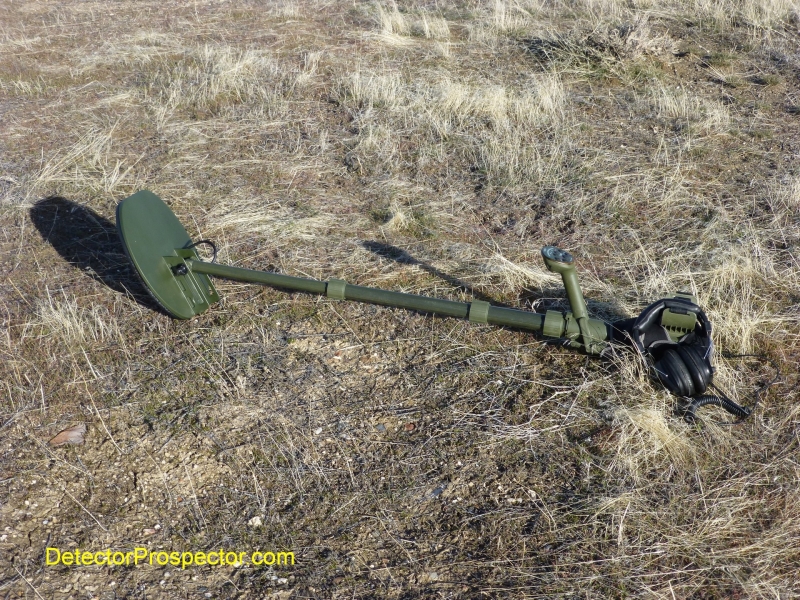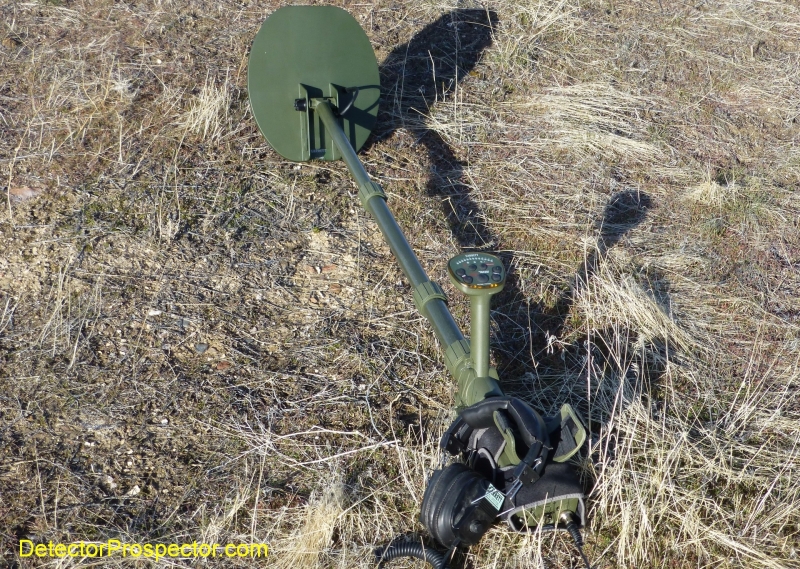Search the Community
Showing results for tags 'garrett atx'.
The search index is currently processing. Current results may not be complete.
-
As ATX users know, it uses two sets of 4 AA batteries. Each going into separate compartments. The other day, my detector said it was going dead after several days of use. Before removing the batteries from their holders, I decided to check the voltage. One set was about 2.4 volts and the other was about 4.9 volts! I am using rechargeable which normally charge up to about 5.1 or 5.2 volts per set. So, one set had little use. The detector was operating normal. What feeds on these batteries...... does one set get more use than the other?
-
I’m a new member from Wasilla, Alaska. I am new to detecting for gold and was hoping you can help me make a final decision on which P.I. detector I want to buy. The reason why I want to get a P.I. Detector is so that I don’t have to worry about hot rocks setting off my detector much like in Petersville, note I have been using a gold bug pro. Now saying that I live in wasilla and knowing that the majority of nuggets are small I will be mainly hunting in relatively close areas such as Hatcher Pass and Petersville. I know that VLF detectors are hard to use in Petersville due to the graphite slate hot rocks. The main reason I am looking towards an SDC 2300 and the ATX machines are because of there ability to be compact for hiking and waterproof which makes it easier to walk through the bushes following streams. Other wise I would love to save up for the relatively new gpz 7000 which I may consider later on down the line or maybe even get a gpx 5000. I like the fact that the 2 machines I am interested in are pretty good on small gold. I want to be able to detect mainly along streams with the thought that if I find a small nugget I would also be able to pan that same spot of a found nugget. The things keeping me from making a decision are the quirks of each machine. ATX can change coils and go deeper which I really like but also don’t like how I hear it can false on targets if bumped into a clump of grass or protruding rocks. I like how the SDC is hot on smaller gold and specimen gold since I think the reality of me finding big nuggets are slim, but I also don’t like the idea of it being a shallow detector and mainly for small gold. Do you think you can help me out on making a decision here?
-
vanursepaul Posted February 25, 2015 Steve, I would like to see you superimpose the ATX on this bar graph to see where it fits. Paul The whole graph isnt there, but you know what i mean, eh? Steve, remember this one? ...Did you ever do it? Maybe you could have a go at superimposing 2 new columns for each of the 3 nugget pics. (space to the left and right of the GPX and GPZ). Time permitting of course! I'm thinking 1 column representing the old style DEEP SEARCHER 15" x 20" coil, and another for the new flat style, 11" x 13" closed DD coil. If you had space,... stretch it, or create a new chart,... you could even throw in the TDI, and even a Golg Bug for reference/fun. Also assuming similar ground conditions, good or bad. For example:- How close is the 11" x 13" DD coil to the STD coil on the GPX 5000? And whats it like against the SDC2300 on small bits? And is the 15" x 20" coil deeper than the STD GPX 5000? And how far away from the GPZ is it, on big bits? Doesn't have to be an exact scientific test orientated job, more of an approximate one based on your time and experience with this machine. I know its not you No1 gold machine (but is, & could be for others), and you love it for wet beaches, but you won't sell it which says a lot about it... I think. With all the latest new vlf stuff (equinox/gm1000/impact/mx sport/at max) getting all the headlines & peoples attention, does no harm to reflect on something old, something different. After all, YOUR elusive/magic/dry land/sub $2000/lightweight/LTX PI machine hasn't arrived yet! (MINELAB/GARRETT/FISHER/NOKTA/MAKRO/XP??? Wonder who will be first then?)....THAT WILL DEFINATELY GET EVERYONE EXCITETED! I don't think its (ATX) a dead duck. I'm still thinking there's more to it (prospecting) than being relegated to a SUPERB beach PI machine. Just don't bring the weight into it!!! Have you tested the closed DD coil? Improved falsing and balance issues? Thankyou in advance! jim
-
I received the deepseeker coil when I obtained my ATX. I have only been using the stock coil to date, but had a few questions on the larger coil. Since my shaft on the stock coil is partially stuck in the extended position (as much as I have tried to loosen it), and I would like to take the ATX to Houston next week on a business trip (that I hope to find time to do a little Galveston beach hunting... suggestions welcomed)... will the 20" be overkill for my intended hunting? What experiences have you had using the deepseeker coil on the beach? What should I know?
-
I am very new to the ATX, just received mine this past Tuesday, but have been out for a few hours each day since, including a couple attepts at a local lake/swimming home. My hunting at this point is mainly geared toward jewelry and coins (prospecting at some point.. but that is another forum). My question is about the iron grunt feature... will a non-iron target give an iron response depending on depth or mineralization surrounding the target? Especially in the lake, where I have to trust the feel of my foot and scoop in murky water... I have experienced several hard hitting targets (both low-high and high-low tones) giving the iron grunt. Am I making a mistake by passing up those targets? Thanks, Tim
-
Going to pick up a garrett atx for nugget detecting which of the packages would you recommend? Have VLF gold detectors but want to venture into pulse now and seems to be the ATX would be a great start.
-
Firstly, thanks for sharing your stories and knowledge here. I can't tell you how grateful I am for the lessons that you have saved me from having to experience for myself. I would be very grateful if some of the ATX users would share some of their Saltwater / Beach set-up preferences and experiences. I am pretty new to the Hobby and I am having a little difficulty trying to work out the best way to set up my ATX for use in saltwater. I live in T&C and the water here is VERY saline as we don't have any rivers. While Steve H has some good info from his ATX in Hawaii, our beaches are more Parrot fish by-product than volcanic sand. Any feedback would be very helpful and much appreciated.
-
I am unfortunately time limited right now, with family stuff occupying quite a bit of time the next couple weeks. However, Garrett was kind enough to rush me a couple of the new 11" x 13" coils to check out and I wanted to give at least a preliminary report on the mono version at this time. The new coils are aimed at a couple issues that owners of previous ATX coils have complained about. First, the rather unique rear hinge design of the stock ATX coils that allows the detector to fold up into a particularly compact configuration. This design has two issues. As the coils age the forward weight tends to cause the coil to slowly sag forward. Not a huge factor but it can result in constant small adjustments to level the coil out. More important it throws the weight of the coil forward, hurting the center of balance. Again, not a huge issue, but one that becomes more apparent if you try and mow through high grass and weeds with the ATX. Garrett came up with an ingenious fix for this issue, that both allows the coil to fold up as desired while delivering that center mount coil so many have craved. The new coil design has a sliding channel that lets you move the coil attachment point from rear to center or anywhere in between. You don't see something really new in metal detecting very often but this really is. And it works. Here is a shot of the new coil with the old design inset into the upper right (Click on all photos for large version). The old stock coil is an epoxy filled 10" x 12" DD design that together with the attached rod assembly weighs 3 lbs 7 oz. The new 11" x 13" mono weighs in at 3 lbs 7.5 oz, again with the attached rod assembly. Basically a wash, although the new coil is slightly larger in overall dimensions. Electronically however it is a much larger coil. A mono coil normally will get better depth than the same size DD coil although in the worst ground DD coils have an edge. DD coils also offer a form of iron discrimination on the ATX that will not work on a mono coil. The ATX seems to be optimized for DD coils and for most gold prospecting the DD coil is probably the better option. For sheer depth on the largest nuggets however mono is often the way to go, and in this case the coil itself is not only a mono but also slightly larger than the stock coil. That is why this coil got my attention first over the 11" x 13" DD version. I made a quick run out to the northern Nevada goldfields. The weather has finally let up but everything is still real wet out east of Reno. I mean real wet - stick to the bottom of your boots mud kind of wet in places. That oddly helped a bit in this case as the ATX is a PI that can easily handle wet salt ground, and in fact it is my favorite salt water detector. The ground balance range runs well into the salt range so I don't think there is any wet salt ground it can't handle. I should point out however that ground balancing out salt does also balance out small gold signals that read identical to the salt signals. This is one of those unsolvable issues with the way current metal detectors work. But better to tune out the worst of the salt in some places and take what gold can be found still. Listening to constant salt signals masks gold also, so there is no perfect solution. In any case, the ATX did prove its capability on this little test run as the ground is both wet and salty where I was, and the ATX 11" x 13" mono ground balanced to it with ease, even with the sensitivity cranked all the way up to the highest setting. Unfortunately I found no gold this day although I did recover some ridiculously small ferrous targets plus some bullets. I did learn a few things to report though. First, the new center mount coils really do balance better and push through grass and weeds much better than the older rear hinge design. The second thing however is more important. One thing I mention in my earliest ATX reports is that "The stock coil is marginally sensitive to false signals when contacting rocks. This is a bit odd since it is an epoxy filled coil so in theory the coil windings cannot move to produce false signals when bumped. The signals do not occur consistently or often but in my case at least happened most often when the coil would catch a rock on the surface and roll the rock under the coil. It is possible that the coil cable, even though protected by being enclosed in the lower shaft assembly, is jiggling enough to produce the signals." I never determined exactly what the cause of these false signals were, but others also reported them. They typically occurred only at higher sensitivity settings and could be tamed with careful coil control, but they were an annoyance. The good news is the new coil design appears to have alleviated this problem. I won't go so far as to say completely eliminated yet, as more hours are needed and more reports from other people under other circumstances, but I did not experience any falsing caused by bumping this coil against rocks or other objects. I was getting some faint signals from running a mono coil at max gain riding directly on salt and mineral ground, but that is because I was in all truth running the sensitivity higher than I perhaps should, a habit of mine. I tend to push my detectors hard. The 11" x 13" mono shares a common mono trait by being hottest around the outside edges. Very small surface targets will tend to signal twice, once for each time an edge passes over the target. This can be handy for knowing you are dealing with tiny surface items before digging a deep hole chasing one. There is also a tendency for the signal to sharpen at the four "corners" of the blunt end coil design. Small targets can be pinpointed by turning the coil on edge and running one of these corners around in the dirt as a sort of pinpointer. When using a plastic scoop to isolate small targets, use those corners as your hot spots. As I noted earlier I am tied up with family business for a while, but I will be reporting more on this and the DD version in the future. These new coils will have me breaking the ATX out for more prospecting this summer than has been my norm in the past. I have tried the 15" x 20" mono coil for the ATX, and frankly this new mono coil in my opinion is a far better option for prospectors. The rear mounted open 20" length of the larger coil made it difficult to handle in the grassy sagebrush areas I frequent. More importantly, I found that although the 15" x 20" coil does offer more depth on very large targets the gains on normal size nuggets were minimal if any and the smaller stuff can't be detected at all. My honest opinion the main benefits with the 15" x 20" are found both in ground coverage and on very large targets but the lack of sensitivity to smaller gold nuggets is a concern. The 11" x 13" mono is a much better size that in my opinion will offer better depth on the larger nuggets prospectors are likely to find than the 15" x 20" mono coil. However, do not think the 11" x 13" is going to be some kind of huge improvement in depth over the stock coil on large nuggets. People always seem to overestimate the advantages of larger coils. That extra inch? Yes. Twice the depth or even 50% more depth? No, don't set yourself up for those kinds of expectations, they are not realistic. If I was buying a new Garrett ATX today for gold prospecting, I would be looking hard at these two new coils because the ATX can now come equipped with one of them as the stock coil. The new knock resistant fully enclosed coil design that is also less likely to hang up on sticks and obstructions. The center mount design handles far better. I don't see how any avid ATX user could be unhappy with this new coil design. The DD coil is still probably the better option for most people with the mono more for those chasing the largest nuggets at depth.
-
Garrett is really disappointing us, I bought an atx when they were released in 2013 Nov, their stock coil had a lot of issues, they never cared. Just imagine 2013!!!! They replied n 2017, with their 2 new expensive coils, (price of an AT gold detector), well currently I was hoping that they will do test and tell us the differences amongst these 3 coils, but they don't bother!!!! Up to now in their Web site there is nothing on performance of their new coils. it seems they are concentrating on vlf detectors and for us, we just took a risk buy buying their PI detector - oh poor zimbabwean I thought Americans were far better than the Australians, now I am stating to doubt, maybe I should have gone minelab, should I buy another coil for atx??? (or it will b another piece of lemon AGAIN) or just sell my atx and get a minelab?????
-
Hi there, is there anyone who have used the 11x13" garrett mono coil so far?how is it,compared to the stock coil??in terms of depth,and mineralization handling??





